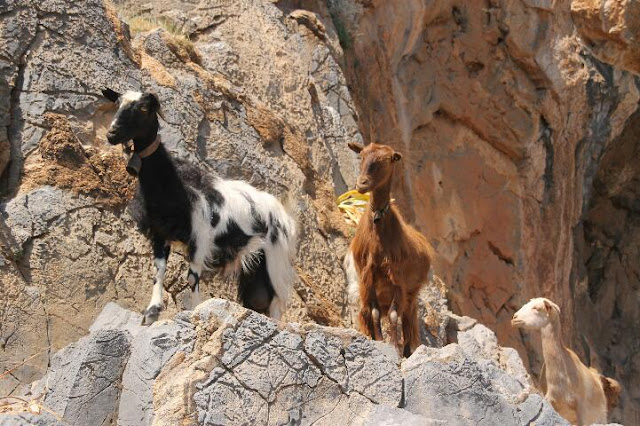None of the hiking on the south coast of Crete is on the flat, and much of it is rugged and at times precipitous. As you creep along a ledge, trying not to dislodge a rock or even look down, it's humbling to see goats cavorting high above you, leaping from rock to crumbling rock. Apparently their vocation is to eat and make us look clumsy and inept. We did come across a number of goat carcasses at the bottom of canyons however, and at least one poor billy stuck on a high ledge, although perhaps he was just taking a brief break from strutting his stuff, still taunting us merely by his ridiculous position.
Tuesday, 30 April 2013
The Aradena Gorge
This chasm is carved by water through the limestone and conglomerates of the mountains above our cove. Starting in alpine meadows, pines and cypresses, it plunges over a thousand meters in about 5 kilometers. 6 of us hired a man with a truck to carry us up the zig-zagging track, a vertigo-inspiring affair from the back of a bouncing pickup.
The village at the top has a sad history, according to our driver. In the local tradition of vendettas, 50 years ago a boy was slapped. Soon after the slapper was shot by the family of the slapped; revenge was taken on the family of the shooter, and so on until 27 people had been killed. Today only a few members of one family live there among the crumbling buildings. This was an area of very tough people, and was never fully subjugated by the Venetians, Turks or Germans. But to throw away that proud history in a meaningless feud seems a travesty.
Anyway, the exhilarating climb down soon erased the somber mood of the ghost village. Tall canyon walls often shaded us on a hot day, and you can see how gorgeous the scenery was. As finale the gorge spits you out onto a perfect stone beach, with clear blue water and caves of marble.
Around Loutros and the Phoenix
As mentioned, we're in an idyllic setting, a small waterfront hotel we found in the perfect cove on Google Earth, a rugged hike to the nearest village, Loutros, itself only accessible by ferry. Phillipe is still with us, and we're also hanging with a fun young British couple, Ian and Lucy, as well as Joan, an American poet living in England, and various other tourists, many of them habitual returnees who love the quiet atmosphere here. The only other company is the large extended family of Greeks who run the place. The men all look like Fidel Castro, and sit smoking, talking and drinking most of the day, alternately friendly and then somehow vaguely threatening, for instance if you ask for something to put on your toast.
Our days are spent swimming in the impossibly clear turquoise sea (warmish, by Georgian Bay standards), making lunch clandestinely so as not to arouse the ire of the proprietor's clan ("why weren't you at the restaurant?"), reading, walking to Loutros for supplies, and hiking the many trails up among the goats.
Mediterranean Blue - Palaiochora to Loutros by Boat
Along the south coast of western Crete is a string of small villages whose best feature is that they're accessible only by sea. We shared a passenger ferry with some Brits, Greeks, Germans, French and a few hapless lambs, east from Palaiochora, stopping at Sougia, Agia Roumeli and finally Loutros, near our destination.
Loutros is the quintessential village hidden from the world; not even a 4 x 4 track can be pushed through its steep surrounding cliffs. It's mostly a series of small waterfront cafes and tavernas with rooms, busy enough in the summer but deserted otherwise - virtually the whole population moves to higher villages with road access. Many of the workers are from places like Albania and Tunisia.
Our hotel, the Phoenix, is even more remote, a short boat ride or 30 minute hike over the headland to the next cove.




















































